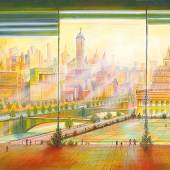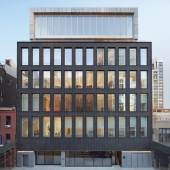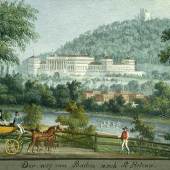Sotheby’s
Abstract Art Pioneer Piet Mondrian’s Signature Grid Masterpiece
-
Auktion14.11.2022
By the time Composition No. II was painted, Mondrian was already well known in international art circles. Peggy Guggenheim and Alfred Barr both courted him for work; Hilla Rebay and Marcel Duchamp stopped by his studio and dozens of young artists visited him in his immaculately designed environment. At the center of the art world in Paris during this time, Mondrian felt at home within the bustling metropolis and the access to new forms of culture, such as jazz, modern dance, and the excitement of fast-moving visual culture that was often associated with nightlife throughout the city. Mondrian was known to stay out all night at Café du Dome and attend the Cirque Médrano in Montmarte. The pleasures of Parisian nightlife were not only for passing the time. As with every aspect of his studied daily routine, these nocturnal outings infused and inspired his work. However, with the deteriorating political situation in Europe, by 1937 Mondrian’s work was being exhibited as Degenerate Art in Germany. Within a year he would leave France, first for England and then, in 1940, for New York, where he would, for the first time in decades, finally abandon the black line in his work as he embarked on a new series within the evolution of his work that was also indebted to the new culture he experienced around him.
Despite being at the vanguard of modernism, and effectively altering its course, Mondrian’s Dutch background and Puritan upbringing were formative influences on his ideas and work, as he sought to infuse a religiously inspired Dutch aesthetic with a radical, modernist fervor. His return from the Netherlands to his studio in Paris in 1919 marked the beginning of a period of intense activity devoted to developing the style that would dominate his work of the 1920s, during which time he confined his pictorial language to planes of pure primary color, planes of non-color and black lines. Over the next decade Mondrian refined this new vocabulary to the highest degree of balance and economy, creating several series of similar works, with each new canvas featuring minor variations in the precise shades of the primary colors, the thickness of the black lines, and the size and shape of the geometrical grids that delineate his compositions. Each work is a unique attempt to express a principle of equilibrium borne out of opposing elements, further amplified by Mondrian’s decision to present his finished canvases in recessed frames.
Mondrian’s studio environment in Paris was a vehicle for creating his work and encountering this carefully constructed world was akin to encountering one of his paintings. He had moved to the French capital in 1911, settling into what, with the interruption of World War I, would be his home until 1938. Alexander Calder visited the studio in 1930, the year Composition No. II was produced, and recalled: “I was very much moved by Mondrian's studio, large, beautiful and irregular in shape as it was, with the walls painted white and divided by black lines and rectangles of bright color, like his paintings.” It was through the careful balance of color – or lack of color – and form expressed through vertical and horizontal lines that Mondrian created his ultimate vision.
Composition No. II carries an illustrious provenance and extensive exhibition history, including a Paris-based show the year it was painted. The work was loaned by Mondrian to the Swedish artist Otto Carlsund in the early 1930s and enjoyed a stint in the collection of Dutch artist César Domela in the late 1940s. The work was later held in the Bartos collection, where it remained until 1983 when it last made an appearance at auction, alongside other important works from their collection by Joan Miró, Alexander Calder, Fernand Léger and Mark Rothko.
-
12.04.2021 - 14.04.2021By Pak • 12- 14 April • A novel collection of digital art redefining our understanding...
-
20.04.2022ARTEXPO NEW YORK CELEBRATES ITS 45TH ANNUAL EDITION WITH A RENAISSANCE IN CONTEMPORARY AND FINE...
-
23.05.2018NEW YORK, 16 May 2018 – Today, Sotheby’s is honored to unveil the full contents of A...
-
Pace Gallery ist eine der weltweit führenden zeitgenössischen Kunstgalerien, die 1960 von Arne...
-
Horst und Wolfgang Szaal über die Entwicklung der Galerie Szaal im Spiegel der Jahrzehnte In...
-
14.11.2022Auktion »
AUCTIONS
New York
14 November
The David M. Solinger Collection15 November
Modern Day Sale22 November
The David M. Solinger Collection:
Art of Africa, Oceania and the AmericasParis
6 December
The David M. Solinger Collection:
Art Contemporain Evening SaleHIGHLIGHTS EXHIBITIONS
Hong Kong
2 – 5 OctoberLondon
9 – 12 OctoberParis
19 – 24 OctoberPRE-SALE EXHIBITION
New York
4 – 14 November














